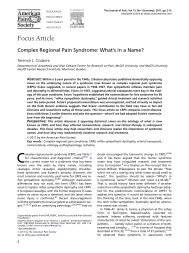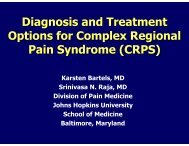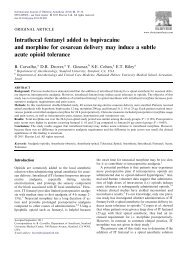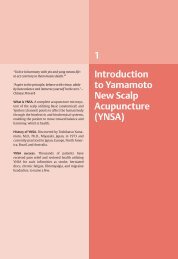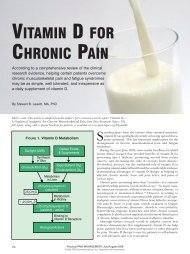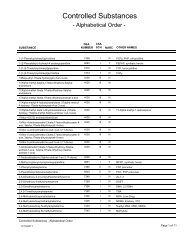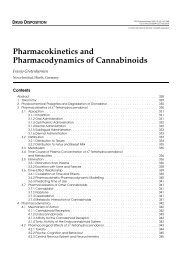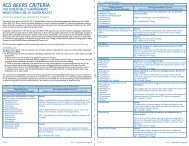GLIA: A NOVEL DRUG DISCOVERY TARGET FOR CLINICAL PAIN
GLIA: A NOVEL DRUG DISCOVERY TARGET FOR CLINICAL PAIN
GLIA: A NOVEL DRUG DISCOVERY TARGET FOR CLINICAL PAIN
You also want an ePaper? Increase the reach of your titles
YUMPU automatically turns print PDFs into web optimized ePapers that Google loves.
REVIEWSNUCLEAR FACTOR-κB(NF-κB). A transcription factorthat is constitutively expressed.Its activation leads (amongother effects) to the productionof pro-inflammatory cytokines.Although constitutivelyexpressed, its ability to move tothe nucleus to bind to DNA istonically inhibited by bindingof IκB.INHIBITOR OF κB(IκB). An inhibitor of NF-κBactivation. It is binding to NF-κBthat keeps this transcriptionfactor from being able to moveto the nucleus to activatemessenger RNA transcription.hyperalgesia persists 20 .Iffurther animal studies supportthis conclusion, this is an important concept forguiding drug development. It would indicate thatminocycline is unlikely to be an effective drug for clinicalpain control.Pro-inflammatory cytokine antagonists. A variety ofbiological modifiers have been developed to target IL-1and TNF. Anakinra (Kineret; Amgen) is a recombinanthuman IL-1-receptor antagonist approved foruse in rheumatoid arthritis 69 .Infliximab (Remicade;Centocor) is a chimeric immunoglobulin G1 antibodyspecific for human TNF-α, approved for use inrheumatoid arthritis and Crohn’s disease 70 .Etanercept(Enbrel; Amgen/Wyeth) is a human TNF receptor/Fcfusion protein approved for use for the treatment ofpsoriatic arthritis 70 .Although anakinra and etanercepthave been successfully used in animal studies to bothprevent and reverse glially driven allodynia and hyperalgesia19,34,46 ,peri-spinal administration was required, asthis family of compounds does not cross the intactblood–brain barrier to any significant degree. Animalstudies support the idea that disruption of pro-inflammatorycytokine action is an excellent target for drugdiscovery,but that the potential of these compounds islimited by the need for a chronic indwelling subduralcatheter to allow daily peri-spinal administration.Pro-inflammatory cytokine synthesis inhibitors. Thisfamily of compounds includes propentofylline (Kronos;Aventis) and thalidomide (Thalomid; Celgene). Othercompounds (leflunomide, methotrexate, p38-MAPkinaseinhibitors and IL-10) also act as inhibitors ofpro-inflammatory cytokine synthesis but, in addition,disrupt pro-inflammatory cytokine signalling. Thesewill therefore be discussed separately later.Propentofylline is an orally active xanthine derivativewhich crosses the blood–brain barrier and is prescribedfor Alzheimer’s disease and vascular dementia 71,72 .Ithas a complex mechanism of action, but its profile ofactions strongly predicts its ability to resolve gliallydriven allodynia and hyperalgesia. Propentofylline hasbeen reported to reduce ischaemia-induced glial activationand proliferation, lipid peroxidation, and IL-1and TNF production 73–75 .In addition, it increases theuptake of extracellular glutamate 76 and increases extracellularadenosine 72 , an endogenous anti-inflammatory 77and pain suppressor 78 .In glial cultures, propentofyllineinhibits release of TNF, IL-1 and superoxide;IL-6 and nitric oxide release are unaffected 79 .Giventhat it is approved for other uses, crosses theblood–brain barrier, suppresses glial activation andreverses (as well as blocks) neuropathic pain behavioursin animals 53 ,propentofylline would seem to bean intriguing candidate for clinical trials that targetglially enhanced pain. However, Aventis is not pursuingfurther drug development on this compound dueto an unfavourable patent situation, inconsistent outcomesof studies as to its efficacy in Alzheimer’s andvascular dementia, and problems with oral delivery ofthe drug 71 .By contrast, thalidomide ([+]-α-phthalimidoglutarimide)and potentially safer analogues are beingactively developed by Celgene for clinical use 80 .Afterbeing banned from the market in 1963 due to the productionof severe birth defects 81 , thalidomide has beenapproved for treatment of erythema nodosum leprosum80 .Thalidomide is orally active and readily crossesthe blood–brain barrier 58,82 .It has a number of actionsthat are consonant with its potential use in controllingglially driven exaggerated pain. In vitro, thalidomideand its analogues can inhibit TNF, IL-1 and IL-6, aswell as increase IL-10 production 83–86 . Systemicadministration decreases TNF production by immunecells, either decreases or has no effect on IL-6 (REFS 87,88),and has no effect on IL-1. Thalidomide also inhibitsTNF- and IL1-induced NUCLEAR FACTOR-κB (NF-κB) transcriptionalactivation, probably as a result of inhibitingthe degradation of INHIBITOR OF κB (IκB) 82,89 . Last, thalidomideand its analogues can increase the concentrationof IL-10, an anti-inflammatory cytokine discussedbelow 57,90 .Animal models of neuropathy have documentedthat systemically administered thalidomidedelays the development of allodynia/hyperalgesia, andis correlated with reduced TNF, unaltered IL-1 or IL-6,and increased IL-10 at the site of nerve injury 56,57 .Given the high blood–brain barrier permeability of thiscompound, thalidomide might be capable of inhibitingpro-inflammatory cytokine production by spinal cordglia, but this potential has yet to be investigated.Although thalidomide failed to reverse neuropathyinduced enhanced nociception in rats 56 , it is notable thatrecent human studies report success in relieving longstanding,intense pain due to complex regional painsyndrome 91,92 .This pain syndrome is not controlled bydrugs developed to target neurons, and recently thehypothesis that spinal cord glia contribute to this enigmaticpain syndrome has been proposed 3 .So thalidomideis a compound worthy of further consideration.How to reconcile these data with reports of thalidomide-inducedneuropathy 58,59,80 is being examined.Disrupting pro-inflammatory cytokine signalling andsynthesis. This group of compounds includes leflunomide(Arava; Aventis), methotrexate (Rheumatrex;Wyeth-Ayerst), inhibitors of p38 MAP kinase, and IL-10.Leflunomide is an orally active malononitrilamide,a disease-modifying anti-rheumatic drug. It isapproved for the treatment of rheumatoid arthritis inhumans 93 .It is metabolized by the liver to form theactive metabolite A771726 (REF. 94). Leflunomideinhibits several pain-relevant substances. For example,it decreases rheumatoid arthritis synovial tissueexpression of IL-1, TNF, nitric oxide and cyclooxygenase-2(REFS 95–97).Also, it disrupts TNF-inducedNF-κB activation, cytotoxicity, production of reactiveoxygen species and lipid peroxidation 98 .Although thisprofile indicates that leflunomide would suppress allodyniaand hyperalgesia resulting from glial activation,concern is raised by the fact that leflunomide hasbroad-ranging immunosuppressive effects. Thisresults from its inhibition of the mitochondrial980 | DECEMBER 2003 | VOLUME 2 www.nature.com/reviews/drugdisc



